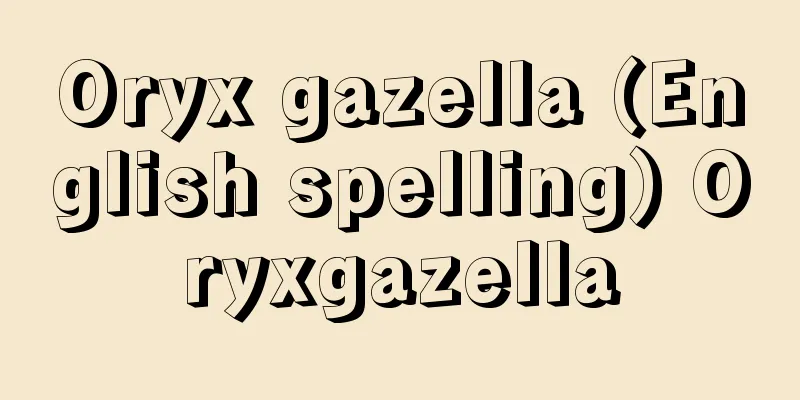Dictionary - Dictionary

|
A book (such as the Japanese Language Dictionary) that organizes and arranges words and characters from a certain perspective and records their readings and meanings. It is also called a dictionary, vocabulary, dictionary, vocabulary, encyclopedia, etc. [Mitsunaga Yayoshi] kindsGenerally, headings of characters or spellings are arranged in alphabetical or hierarchical order for ease of searching. In China, because there is no way to arrange Chinese characters, dictionaries are divided into three types: by radical order or by phonetic order, and by character shape, phonetic order, and interpretation order. In addition to comprehensive dictionaries, Japanese dictionaries include dictionaries of ancient words (classical language, elegant language), dialects (slang), slang, modern language, foreign words, synonyms, historical facts and proverbs, etymology, pronunciation accent, grammar, and technical terms, as well as Chinese-Japanese dictionaries and bilingual dictionaries that compare two or more languages. Comprehensive dictionaries include large dictionaries with over 400,000 headings (complete dictionaries), medium-sized dictionaries with the same number of headings (desk dictionaries), and portable pocket or pocket dictionaries. Comprehensive dictionaries have developed from dictionaries that focused on archaic languages, and tend to shift from focusing on standard Japanese to focusing on modern common language, and to include encyclopedic information. [Mitsunaga Yayoshi] Using the dictionaryIn the West, dictionaries developed to interpret Latin words by comparing them with their own language. In China, dictionaries and the study of exegesis were used to learn the shapes and meanings of characters. Ideally, all words and characters should be interpreted, but since this is impossible, the goal is to serve a certain level of user. Therefore, for this purpose, the actual usage of vocabulary is investigated, and the selection of vocabulary and the adoption of headings are the first priority, so users need to know the types and trends of dictionaries. Next, since interpretations cannot be comprehensive, it is important to know the hierarchy of word usage, regional and academic differences, usage and citation examples, and the tendency to incorporate idioms and phrases. Of course, attention should be paid to the origins of native Japanese words, but also to foreign words. For dialects, it is better to use reliable sources. Attention should also be paid to pronunciation, accents, kana spelling, parts of speech, inflections, and variant characters. [Mitsunaga Yayoshi] History – The WestLike Western culture, dictionaries can also be traced back to Greece. In the 2nd century BC, Aristophanes, head of the Library of Alexandria, criticized the original texts of Homer and others and compiled the Greek Dictionary of Difficult Words, and in the 1st century later, Pamphilus of Alexandria compiled a 95-volume dictionary. In Rome, Marcus Verrius Flaccus created an alphabetical dictionary called De verborum significatu in the 1st century. In the Middle Ages, when Latin was at its peak, many dictionaries were created, one of which was a dictionary of the Bible compiled by Giovanni Balbi of Genoa in 1286. Around 1560, Gutenberg printed Catholicon . Also, in 1613 (1612?), the Italian Academy compiled the Vocabolario degli Accademici della Crusca (Dictionary of the Academy of the Crusca) as part of a policy to purify and establish the national language, which was in use until the 1920s. In 1694, the French Academy also compiled the Dictionnaire de l'Académie française (Dictionary of the Academy of the Crusca) for the same purpose, which went through eight editions by 1935. In England, which did not have a national language policy, the first Table Alphabeticall was compiled by Robert Cawdry in 1604, which contrasted English with Hebrew, Greek, Latin, etc. [Mitsunaga Yayoshi] EnglandThe ancestor of modern dictionaries is An Universal Etymological English Dictionary (1721) by Nathan Bailey (?-1742), which includes quotations from literary figures such as Chaucer and Shakespeare, and the two-volume revised edition in 1727 was the authority until the appearance of Samuel Johnson's dictionary. Johnson aimed to establish correct English, and published A Dictionary of the English Language in 1755, which was recognized as an authority in English studies and dictionaries. This dictionary contained 40,000 words and was known for its clear definitions and the abundance and accuracy of quotations. However, with the advancement of linguistics, it was criticized for being too subjective, and in 1836-1837 Charles Richardson (1775-1865) published A New Dictionary of the English Language , which clarified the changes in the meaning of words over time. As a result of the British Philosophical Society debating the need for a dictionary that would clarify the historical changes in the English language, in 1858 it commissioned Herbert Coleridge (1830-1861) and Frederick J. Furniwell (1825-1910) to be editors, but progress was delayed due to their separate jobs. In 1879, Oxford University Press (OUP) offered a grant to speed up the project, and linguistic authority Sir James A.H. Murray (1837-1915) was put in charge of editing full-time. The first volume of A New English Dictionary on Historical Principles was published in 1884, and 13 volumes were completed in 1928 (it was renamed the Oxford English Dictionary (OED) in 1933. It published 12 volumes and 1 supplement, with 7 supplements in 1972). It contains 420,000 English words from Chaucer's time and over 2 million quotations, is devoted to linguistics, and is said to be a typical modern dictionary. [Mitsunaga Yayoshi] AmericaIn America, Webster completed two large volumes of An American Dictionary of the English Language in 1828, adding American spelling and pronunciation, and today it has grown to 800,000 words. Modern dictionaries include The Random House Dictionary of the English Language (1966, 280,000 words). American English includes A Dictionary of American English on Historical Principles (1938-1944, 4 volumes), co-edited by William Craigie (1867-1957) and James R. Hulbert, and A Dictionary of Americanisms on Historical Principles (1951) by Mitford M. Mathews (1891-1985). [Mitsunaga Yayoshi] GermanyGermany was divided into many regional languages, north and south, and there was no unification. The first dictionary was the Teuthonista oder Duytschlender ( German-Latin Bilingual Dictionary) by G. van der Schueren, published in Cologne in 1477. However, the great project of incorporating the entire German language and scientifically compiling it was undertaken by the Brothers Grimm. The elder brother Jacob was a linguist who established the scientific principle of phonological shift in "Grimm's Law." Together with his younger brother Wilhelm, he attempted to scientifically compile a dictionary of their native language, traveling to the outskirts of German-speaking regions to collect information and to investigate the actual state of a huge amount of linguistic material. The folk tales they collected were compiled into two volumes of Kinder-und Hausmärchen (Grimm's Fairy Tales) (1812, 1815), but as a result of the struggle to edit these huge materials, the first volume of the Deutsches Wörterbuch (German Dictionary) was published in 1854. However, the brothers died one after the other, leaving the dictionary incomplete. Many linguists followed suit, and finally, in 1960, 100 years later, with the cooperation of the East and West German Academies, the 32 volumes were completed, a century and a half after the project was first conceived. Although future revisions will be necessary due to the progress of linguistics in the intervening years, these basic materials are a brilliant monument of linguistics. Also, Paul Hannan (1846-1921), who was critical of the Brothers Grimm, published the Deutsches Wörterbuch (German Dictionary) in 1897. Moritz Heyne (1837-1906) also published the Deutsches Wörterbuch (German Dictionary) in three volumes (1904-1906). Between 1939 and 1957, Trübner published the eight volumes of the Trübner German Dictionary, co-edited by Alfred Götze (1876-1946) and Wilhelm Mitzka (1888-1976). [Mitsunaga Yayoshi] FranceThe first was a comparative dictionary between French and Latin, published in 1539 by Robert Estienne (1503-1559) in the Dictionnaire latin-français . In 1690, the writer Furtier criticized the Academie's focus on court jargon in its editing, and after more than ten years of hard work, he published the Dictionnaire universel, contenant généralement tous les mots françois in Geneva, aiming for a dictionary that would be used by the people. The modern French dictionary was the Dictionnaire de la langue française (Dictionary of the French Language) published by Littré in four volumes from 1863 to 1873 (with one supplement in 1877), which was later published in seven volumes by Hachette with additional supplements (1956-1958). A rival to this is the new edition of the Grand Larousse de la langue française (Grand French Dictionary) in 7 volumes (1971-1978) by Larousse Press. The same company also published Le petit Larousse illustré (Little Illustrated Larousse) in 1906, which was revised by dictionary editor Claude Auge (1854-1924) and has been widely used ever since. [Mitsunaga Yayoshi] SpainIn Spanish there is the Dictionary of the Academies ( Diccionario de la lengua castellana ) (1726-1739 edition, revised 1936-1939), and the Treasury of the Castelan Language ( Tresora de la lengua castellana) (1611 edition) by Sebastián de Covarrubias y Orozco (1539-1613). [Mitsunaga Yayoshi] History - The EastChinaEastern culture originated in China. In the 2nd century BC, scholars of the Former Han Dynasty compiled interpretations of the Five Classics in the form of a dictionary. The 19 volumes of the Erya are annotations of difficult words, and since they contain quotations from ancient texts, they can be seen as the beginning of a similar book. This was developed into the 8 volumes of the Shakumyo, compiled by Liu Xi in the Later Han Dynasty, which is called a Kunko because it only contains explanations of words. A complete dictionary that includes the shapes of characters, their pronunciations, and explanations is called a zishu, and a typical example of this is the 15 volumes of the Shuowen Jiezi, compiled by Xu Shen in the Later Han Dynasty, which provides explanations of over 9,300 Chinese characters and was revered as the source of later philology. In the late Qing Dynasty, the research of Duan Yucai and others gave rise to the school of historical inquiry. Gu Ye Wang (519-581) of the Liang dynasty expanded it into the 30-volume "Jade Pian" (543). After being expanded by Sun Qiang of the Tang dynasty and revised by Chen Pengnian (961-1017) of the Song dynasty, it became widely used. The Tang "Jade Pian" was also widely used in Japan, where the "He Jade Pian" was created during the Muromachi period and was also printed in the early Meiji period. In 1716, at the beginning of the Qing dynasty, Zhang Yushu (1642-1711) and others compiled the 42-volume "Kangxi Dictionary" by imperial decree, containing over 47,000 characters, and was a comprehensive compilation of dictionary works since the Shuowen Jiezi, becoming the model for subsequent published dictionary works. It was also used in Japan during the Meiji period, which led to the development of Chinese-Japanese dictionaries. The origin of rhymed books is the "Cut Rhyme" (601) by Lu Fayan (c. 560-?) of the Sui dynasty, which was expanded and revised by Sun Xi of the Tang dynasty to become "Tang Rhyme", but these works no longer exist. Qi Lun of the Song dynasty revised the "Guang Rhyme" into five volumes (1008) using the Song rhyme, and Yuan Du (990-1053) and others completed the 10 volumes of "Collected Rhymes" in 1037. In 1711, at the beginning of the Qing dynasty, Zhang Yushu and others imperially commissioned the 106 volumes of "Peiwen Rhyme Office", which was further expanded in 1716, eventually reaching 444 volumes. The main characters are arranged in 106 rhymes, idioms are grouped together in rhymes, and the definitions are also provided as example poems, so this was widely used in composing poetry. During the Republic of China era, various dictionaries appeared under the influence of Western and Japanese dictionaries. Lu Erkui and others compiled the three volumes of the Ciyuan (Ciyuan) from 1915 to 1931, which had many elements of an encyclopedia (combined in 1945). Zhu Qifeng compiled two volumes of the Citong (Citong) in 1934 based on the Kangxi Dictionary. In the same year, Shu Xincheng (1893-1960) and others published three volumes of the Cihai (Cihai), which also served as an encyclopedia. The following year, Xu Yuanji and others compiled four volumes of the Great Chinese Dictionary. This dictionary focuses more on the changes in the meaning of Chinese sentences than the Kangxi Dictionary, contains many example sentences, and has many elements of an encyclopedia. [Mitsunaga Yayoshi] KoreaThe six-volume "Great Dictionary" is a representative dictionary of the Korean language. Work began in 1929 to rectify the deterioration of the native language caused by Japan's "assimilation policy," and in 1936 the Korean Language Society took over, setting standard vocabulary, standardizing spelling, and beginning compilation. However, the group was arrested by the Government-General, and although the first volume was published in 1947, work was halted by the Korean War, and after much effort it was finally completed in 1957. It contains 164,000 words and also contains encyclopedic elements. [Mitsunaga Yayoshi] JapanChinese dictionaries were widely used in ancient Japan. The Gyokupian became a lost book in China, but parts of old manuscripts remain at Ishiyama-dera Temple and Waseda University. In addition, the Yangshi Kango Sho and Benshoku Risei were created in the Nara period, and the Togu Kiriyun was compiled by Sugawara no Koreyoshi, as can be seen in the Nihonkoku Kenzai Shomokuroku. In 850 (Kasho 3), Kukai compiled the 30 volumes of the Tenrei Bansho Meigi, adding annotations and readings necessary for Japanese people to the abbreviations of the Gyokupian, and arranging the text in a radical-commentary order. During the Shotai era (898-901), the monk Shoju (856-901?) compiled 12 volumes of the Shinsen Jikyo, which included over 21,300 characters from the Gyokuhen and other works, with Man'yōgana readings. The Ruiju Myōgisho (author unknown), compiled in 10 volumes at the end of the Heian period, contains 32,000 kanji characters, with faithful Japanese readings for over 10,000. [Mitsunaga Yayoshi] The emergence of Japanese dictionariesThe first dictionary of Japanese language was the "Wamyo Ruijusho" compiled by Minamoto no Shitago around the Johei era (931-938), and is available in 10 volumes (24 categories) and 20 volumes (32 categories). It classifies various nouns and provides quotations for their Japanese readings and interpretations, and is both a dictionary and an early form of encyclopedia (ruisho). It became known to academics at the end of the Edo period due to the research of Kariya Ekisai (published by the Printing Bureau in 1883). Tachibana no Tadakane first compiled the two-volume "Iroha Jiruisho" in the Iroha order during the Tenyo-Jisho era (1144-1181), which eventually became a three-volume edition and was further expanded to the ten-volume edition "Iroha Jiruisho." This includes Chinese words in addition to Japanese words and is arranged in Iroha order. In the Middle Ages, the two-volume "Kagakushu" (1444), which classified the different writing styles, was said to have been written by Toroku Hanou, and became popular in the Edo period. The "Setsuyoshu" was created in the mid-Muromachi period, and the Ise version was old and popular, while the Inui version and the Indian version developed into three lines, which were used by the common people as reference books and valuable records. It seems that the "Gyokuhen" was revised into the Japanese-style "Wagyokuhen" in three volumes before Bunmei (1469-1487), and after the Keicho version was published, it became popular in Edo. Kokan Shiren, a scholar of the Five Mountains, compiled the first Japanese rhyming poetry book, the five-volume "Shubun Inryaku" (Shubun Inryaku), with a preface in 1306 (Tokuji 1), which became popular. It was only in the Edo period that linguistic and scientific dictionaries of the Japanese language finally appeared. Tanigawa Kotosuga compiled the 93 volumes of the "Wakun no Shiori," which contains vocabulary from archaic to modern Japanese, arranged in alphabetical order, with explanations and quotations. The first part was published in 1777 (An'ei 6) and then discontinued, the second part in 1877 (Meiji 10), and in 1898, Inoue Yorikuni and Kosugi Sugimura (1834-1910) co-edited and revised the dictionary to publish the "Zouhou Wakun no Shiori." Ishikawa Masamochi compiled the Gagen Shuran from 1826 to 1849 (Bunsei 9 to Kaei 2), but Nakajima Hirotari's revised edition was completed in 1887 in 57 volumes. It arranged ancient words in alphabetical order, with sources cited for interpretation. Ota Zensai's Rigen Shuran (Collected Words), 26 volumes, has been passed down in manuscript form, and in 1899 was revised by Inoue Yorikuni and Kondo Heijō (1832-1901) to become the Zoho Rigen Shuran (Augmented Rigen Shuran). Koshigaya Gozan (1717-1787) compiled a dictionary of dialects from around Japan in five volumes, Butsurui Shoko (Names of Things). Kaibara Ekiken's "Nihon Shakumyo" in 3 volumes (published in 1700) and Arai Hakuseki's "Touga" in 20 volumes (completed in 1717) are both excellent etymological dictionaries. [Mitsunaga Yayoshi] Dictionaries from the Meiji period onwardsAfter the Meiji Restoration, with the rise of movable type printing, many dictionaries were printed. First, the Ministry of Education commissioned 10 scholars, including Kimura Masakoto, to edit "Goi," but this was discontinued after the first 13 volumes due to financial difficulties. However, Otsuki Fumihiko took over the project, modelled on Western linguistics dictionaries, and published a book between 1889 and 1891 (Meiji 22-24). This was "Genkai," which went through over 100 editions. After his death, the expansion was continued by Okubo Toshio and others, and with the support of the Japanese Language Department at the University of Tokyo, it was expanded to five volumes, "Daigenkai," and published between 1932 and 1937 (Showa 7-12). Other works include the Small Japanese Dictionary edited by Mozume Takami and the Chinese-English Iroha Dictionary (1886) edited by Takahashi Goro (1856-1935). Kanazawa Shōzaburō's Jirin (1907) was written in a new style and had many innovations, such as referencing Korean as the etymology of words. Later, Shinmura Izuru's Jien (1935) was published. Matsui Kanji, working with Ueda Kazutoshi, published the Dai Nihon Kokugo Jiten (Great Japanese Dictionary) in five volumes between 1915 and 1919 (Taishō 4-8), which was highly praised for its rigorous and scientific interpretation of the Japanese language and the accuracy of its quotations. Haga Yaichi revised and expanded Ochiai Naofumi's Kotoba no fountain (5 volumes, 1898) into the Nihon Daijiten Gensen (Japanese Dictionary, 6 volumes, 1921-1929), doubling the number of proper nouns (270,000 words). Heibonsha compiled the Daijiten (Dictionary, 26 volumes, 1934-1936) which added an encyclopedic element by compiling 600,000 words. Shogakukan further completed the Nihon Kokugo Daijiten (Japanese Language Dictionary, 20 volumes, 1972-1976), which included 620,000 words, added encyclopedic elements, and provided 2 million quotations and examples. Jirin was revised and expanded into the Kojirin (1925), and expanded into the Cikai (Cikai), which expanded into the Meikai Kokugo Jiten (Meikai Kokugo Jiten), focusing on modern Japanese. The Jiten dictionary was also a medium-sized dictionary with encyclopedic elements, but it developed into the Kojien dictionary (1955). For archaic words, there is Sanseido's Era-based National Language Dictionary: Ancient Japanese Edition (1967), the Japanese Ancient Language Dictionary (1929) edited by Matsuoka Shizuo (1878-1936), the Ancient Language Dictionary (1967) edited by Maruyama Rinpei (1891-1974), and the Comprehensive Index of Ancient Characters (1958-1959) edited by Nagashima Toyotaro, which is the parent character index for Shinsen Jikyo and eight other ancient dictionaries. There are also various other dictionaries such as the National Dialect Dictionary (1951) edited by Tojo Misao, the Dictionary of Foreign Words (1941, revised in 1977) edited by Arakawa Sobei (1898-1995), the Dictionary of Slang Words (1901-1976) edited, and the Asahi Dictionary of Modern Japanese (1972, edited by the Asahi Shimbun Company). [Mitsunaga Yayoshi] Chinese dictionaryDuring the Edo period, the Chinese "Kangxi Dictionary" and "Yupian" were used as dictionaries of Chinese words, but in the Meiji period they developed into Chinese-Japanese dictionaries. The "Shinkaijikai" edited by Ogita Sho in 1868 (Meiji 1) and the "Meiji Dictionary" edited by Ino Chuko in 1885 merely added compound words to the basic characters of the "Kangxi Dictionary," but the "Kanwa Daijiten" edited by Sanseido in 1903 (Meiji 36) was based on the "Peiwen Yunfu" dictionary and created the format of a Chinese-Japanese dictionary. The New Translation of the Chinese-Japanese Dictionary (1912) edited by Hamano Tomosaburo (1869-1941) was the first to arrange compound words by their first character, to change the rhyme order, and to simplify the definitions. Following this, a series of distinctive Chinese-Japanese dictionaries were published, including the Detailed Explanation of the Chinese-Japanese Dictionary (1916) edited by Hattori Unokichi and Oyanagi Shigeta (1870-1940), the Great Dictionary (1917) edited by Ueda Mannen and Sakaeda Takei (1879-1962), the Origin of Characters (1923) edited by Kanno Michiaki, and the New Revised Chinese-Japanese Dictionary (1932) edited by Oyanagi Shigeta. Of these, the Great Dictionary looked for definitions in explanatory texts and made major changes to the search system. The 13-volume "Dai Kanwa Jiten" (Great Chinese-Japanese Dictionary) (12 volumes and 1 index volume) compiled by Morohashi Tetsuji was completed between 1927 and 1960 (after the first volume was published in 1943, work was halted due to destruction in an air raid, and all 13 volumes were published between 1955 and 1960). It surpasses the "Kangxi Dictionary" with 50,000 original characters, 520,000 idiomatic phrases, and approximately 2 million quotations from historical events, and is the result of many years of hard work. [Mitsunaga Yayoshi] Western Japanese DictionaryThe study of Japanese by Westerners, including Jesuits, is important from the standpoint of linguistics. Jesuit dictionaries were compiled for the needs of missionary work, and the first was the Jesuit edition of the Dictionaricum Latino-Lusitanicum, ac Iaponicum, published in 1595 (4th year of Bunroku) at the Amakusa College. This was a Latin-Italian Bilingual Dictionary by Ambrosio Calepino (c. 1440-1510) with Portuguese and Japanese words inserted into it. This dictionary was revised in Manila in 1630 as the Japanese-Spanish Dictionary, edited by the Dominicans, and in Rome in 1632 as the Latin-Japanese Bilingual Dictionary, edited by Collado. In 1598 (Keicho 3), the Jesus Society published the Rakuyoshu in cursive Chinese characters and hiragana type. It was 810 pages long and divided into Chinese and Japanese words, with the addition of the Kodamahen section. In 1603 (Keicho 8), the Nippon-Portuguese Dictionary (Vocabulario lingua de Iapam com adeclaraça em Portugues) was completed, and the following year in 1604 an expanded edition was published, a groundbreaking work that collected words from the Gegakushu, Setsuyoshu and other works, as well as common terms of the time. Rodrigues was the central figure in these projects. Unfortunately, only one or two copies remain in existence in the world. Furthermore, Pages compiled the Japanese-French Dictionary (1862-1868) from the Roman edition, and Hepburn completed his famous Japanese-English Dictionary, which was printed in 1867 (Keio 3) by the American Presbiterian Mission Press in Shanghai and published in Yokohama (reprinted in 1872/3rd edition 1886, Maruzen). In the Dutch context, the book "Halma Wage" bore fruit. In 1796 (Kansei 8), Sanpaku Inamura translated the Dutch-French Dictionary Woordenboeck der Nederduitsche en Fransche Taalen (1708), compiled by François Halma (1653-1722), into Japanese with the help of former Dutch interpreter Ishii Shōsuke (Tsuneemon) (1743-?) and Udagawa Genzui, and printed 30 copies of the 13-volume "Halma Wage." This is known as "Edo Haruma." In 1798, Morishima Nakara (of Bansho-tei) created the Ruiju Koumougoyaku, dividing Japanese into 20 types and printing Dutch words in katakana, but in 1848 (Kaei 1) he renamed it the Revised and Enlarged Bango-sen and published it. In Nagasaki, Doeff translated the aforementioned Haruma dictionary with Yoshio Gonnosuke (1785-1831) and other interpreters, and presented the eight volumes of the Doeff Haruma to the shogunate in 1816 (Bunka 13). He was then ordered to make further efforts in corrections, and eleven interpreters joined in. This became known as the Nagasaki Haruma. Using this and the dictionary by Petrus Weiland (1754-1841), Katsuragawa Hoshu compiled the 12 volumes of "Oranda Jiji" (Holland Jiji), which he published between 1855 and 1858 (Ansei 2-5). [Mitsunaga Yayoshi] English DictionaryEnglish dictionaries were originally of Dutch origin, but later of American origin. Motoki Shozaemon (1767-1822), an interpreter, compiled the Angeria Kokugo Waku (The Reconciliation of the Angelian Language) under the orders of the Shogunate and with the assistance of Jan C. Blomhoff (1779-1853), which he expanded and revised in 1814 (Bunka 11) and renamed the Angeria Gorin Taisei (The Complete Anger Language). Murakami Hidetoshi published the Sango Benran (Handbook of Three Words) in 1854 (Kaei 7), comparing Japanese with three words in English, French, and Dutch, and in the same year added Latin words, expanding the edition into three volumes of Goho Tsugo (The Words of the Five Directions). In 1862 (Bunkyu 2), Hori Tatsunosuke (1823-1894) and others at the Bansho Shirabesho (Institute for the Investigation of Foreign Documents) published the English-Japanese Pocket Dictionary, which they then reprinted in 1867 (Keio 3), but the original was the 1857 edition of New English-Dutch and Dutch-English Pocket Dictionary, edited by H. Picard (1810-1858?). The next British dictionary was published in 1830 (Tenpo 1) by the missionary Walter Henry Medhurst (1796-1857) in Batavia, who published An English and Japanese and Japanese and English Vocabulary . He had never been to Japan and had only studied documents. Medhurst's dictionary was reprinted in 1857 as "Eigo-sen," with the first three volumes proofread by Inoue Shuri, and in 1863 the last four volumes proofread by Murooka Toyo and others. In the United States, "Eiwa Jiyo," jointly translated by Shibata Shokichi (1841-1901) and Koyasu Takashi (1836-1898), was published by Nisshusha in 1873 (Meiji 6), and became famous for its illustrations. The original was the Comprehensive English Dictionary (1863) edited by John Ogilvie (1797-1867). Next, F. Warrington Eastlake (1858-1905) and Tanahashi Ichiro co-translated Mr. Webster's New Encyclopedia: Japanese Translation Vocabulary, published by Sanseido in 1888, followed by the New English-Japanese Dictionary (1901) edited by Wadagaki Kenzo (1860-1919), the New English-Japanese Dictionary (1902) edited by Kanda Naibu and others, the English-Japanese Dictionary with Idioms as the Main Object (1925) edited by Saito Hidesaburo, and the New English-Japanese Dictionary (1927) edited by Okakura Yoshisaburo. In 1980 Kenkyusha expanded it to a dictionary of 230,000 words. [Mitsunaga Yayoshi] German DictionaryGerman began with the "Fugo-sen" (Putongpu) translated by Nakamura Yukichi in 1871 (Meiji 4), followed by the "German-Japanese Dictionary" (1940) edited by Kimura Kinji and Sagara Morimine, and the "Dai German-Japanese Dictionary" (1958 edition, 140,000 words) edited by Sagara Morimine. The most recent dictionary is the "Dai German-Japanese Dictionary" (1985 edition, 150,000 words) edited by Kunimatsu Koji (1906-2006) and others. [Mitsunaga Yayoshi] French DictionaryFrench began in 1871 (Meiji 4) with the publication of the Official French-Japanese Dictionary (Shanghai Meihua Shoin), edited by Thomas Nugent (?-1772) and translated by Kojudo (Okada Yoshiki, 1848-1926). The four volumes of the French-Japanese Dictionary translated by Nomura Yasuyuki (1852-1935) were a translation of Littré's abridged version published in 1886-1889. Hakusuisha's Model French-Japanese Dictionary (1931) was an expanded version of the Small Illustrated Larousse. The Standard French-Japanese Dictionary (edited by Suzuki Shintaro, Asakura Sueo (1909-2001) and others) was published in 1957 (Showa 32) after about ten years of hard work (just under 70,000 words). Other examples include the French-Japanese Dictionary edited by Ibuki Takehiko et al. (1981 edition, just under 80,000 words). [Mitsunaga Yayoshi] "My Dictionary" edited by Kobayashi Hideo (1973, Maruzen)" ▽ "Dictionary History by Sogo Masaaki (1973, Asahi Shimbun)" ▽ "English and American Dictionaries - History and Current Status by Nagashima Daisuke (1974, Kenkyusha Publishing)" ▽ "Making a Dictionary by Mibo Gouki (1976, Tamagawa University Press)" ▽ "The Story of English Dictionaries by Kashima Shozo (1976, Kodansha)" ▽ "An Outline of Ancient Dictionaries by Kawase Kazuma (1977, Yushodo Bookstore)" ▽ "My Theory of Dictionaries by Fukumoto Kazuo (1977, Kawade Shobo Shinsha)" ▽ "The History of Modern Japanese Dictionaries - Imitation and Creativity, Volumes 1 and 2 by Yamada Tadao (1981, Sanseido)" ▽ "The Story of Dictionaries by Kato Koji (Chuko Shinsho)" ▽ "Japanese Language and Dictionaries" by Toshio Yamada (Chuko Shinsho) [References] | | | | | | | |Ueda Mannen| |Edo Haruma| | | Horan | | | Hoshu| Kariya Seisai|Kanda Nobu| | | | | | | | | | | | | | |Shinno | Deity| | | | |Tsaiji| Shintaro| | |Secret-explanation| | Daiji| | | |Tojo Misao| | | | |Haga | | |Thought-name| | Shuji|Banzotei| | | | | |Ryujun- | | | |A practical, old-style dictionary. It has 214 radicals and contains approximately 47,000 characters. "School Collection" edited by Zhang Yushu, Chen Trien Jing et al., Toga Ting Zhengang School, published in 1780 (Annaga 9)"> "Kangxi Dictionary" At the end of the Heian period, the meaning of each kanji was expressed in katakana, and many more idioms with two or more characters became practical. "Some 1" Reproduction of the National Diet Library "> "Ryuju Nagisho" Old type version, 20 volumes, left page is "Tenbe Daiichi", Genjunsen, published in the National Diet Library, held around 1617 "> "Wamy Ruijusho" A practical Japanese dictionary with a classification system. It classifies and explains about 3,000 words from the Muromachi period into 18 categories. Volume 1 "Tenchimon Daiichi" by Toroku Hajime, printed version published in 1617 (Genwa 3), held at the National Diet Library . "Gegakushu" "Banjuya Books for the Books of the Books" Isemoto, collection of National Diet Library at the end of Muromachi"> "Shoku Collection" A Chinese-Japanese book written in the Muromachi period. It is also written as "Yamatama" (Japanese-style kanji). Alongside the kanji, the sound is shown below, and the Japanese-style kun is shown. Volume, edition, published in 1613 (Keisho 18), the National Diet Library "> "Wagata" Satsuma version, 5 volumes, by Tokan Shiren, published in 1481 (Bunmei 13), held at the National Diet Library "Collected Rhymes" Source: Shogakukan Encyclopedia Nipponica About Encyclopedia Nipponica Information | Legend |
|
ことばや文字をある視点から整理して配列し、その読み方、意味などを記した書物(日本国語大辞典など)をいう。辞書、辞彙(じい)、字典、字彙、字引などともいう。 [彌吉光長] 種類一般に文字または綴字(てつじ)の標目を五十音またはアルファベット順に配列し、検索の便を図る。中国では漢字に配列の手段がないので、部首順または音韻順により、また字形、音韻および訓詁(くんこ)(解釈)の3種の辞典に区別される。日本語の辞典の種類は、総合的辞典のほかに、古語(古典語、雅語)、方言(俗語)、隠語、現代語、外来語、類語対語、故事俚諺(りげん)、語源、発音アクセント、文法、専門用語の諸辞典があり、さらに漢和辞典、2国語または数か国語対照辞典bilingual dictionaryがある。総合辞典には標目数四十数万の大辞典(完全辞典complete dictionary)、同十数万の中型辞典(机上辞典desk dictionary)、携帯用の袖珍(しゅうちん)またはポケット辞典がある。総合辞典は古語中心の辞典から発展し、標準語中心から現代通用語中心になり、百科事典的な情報を収容していく傾向がある。 [彌吉光長] 辞典の利用辞典は、西洋でラテン語の解釈を目的に自国語との対照から発展した。中国では字形や意味を知るためで、字典と訓詁の学がある。理想としてはあらゆる語彙(ごい)と文字を解釈すべきであろうが、それは実現不可能なため、どんな階層の利用者のためかが目標とされる。したがって、その目的で語彙の通用の実態を調査し、語彙の選定と標目語の採択を第一義とするので、利用者は辞典の種類と傾向を知る必要がある。次に解釈も網羅的というわけにいかないので、語の使用階層、地方・学術などの差、用法と引用例、熟語・成句の取り入れの傾向を知ることが重要である。固有の和語はもちろん、外来語の語源にも注目すべきである。方言などは確実な資料によるものがよい。発音、アクセント、仮名遣い、品詞、変化、文字の異体にも注意が必要である。 [彌吉光長] 歴史――西洋西洋文化と同じように辞典もギリシアに起源が求められる。紀元前2世紀アレクサンドリア図書館長アリストファネスはホメロスなどの原典批判を行うとともに『ギリシア語難語辞典』を編し、後1世紀になるとパンフィルスPamphilus of Alexandriaが集大成した辞典95巻を編した。また、ローマでは1世紀にフラックスMarcus Verrius Flaccusが『語義論』De verborum significatuというアルファベット順の辞典形式をつくった。中世にはラテン語全盛時代で多くの辞典がつくられたが、その一つに1286年バルビGiovanni Balbi of Genoaが編した聖書の辞典がある。1560年ごろにはグーテンベルクが『カトリコン』Catholiconを印刷した。また、1613(1612?)年には、イタリアのアカデミーが自国語の純化確立政策から『アカデミア・デラ・クルスカ辞典』Vocabolario degli Accademici della Cruscaを編し、これは1920年代まで通用した。1694年になると、フランスのアカデミーも同じ目的で『アカデミー辞典』Dictionnaire de l'Académie françaiseをまとめ、1935年に8版を重ねた。国語政策をとらなかったイギリスでは、コードリーRobert Cawdryが編した1604年の『アルファベット語表』Table Alphabeticallが最初のもので、ヘブライ、ギリシア、ラテン語等と英語を対照させた。 [彌吉光長] イギリス現代的辞典の祖先はベイリーNathan Bailey(?―1742)の『万有語源的英語辞典』An Universal Etymological English Dictionary(1721)で、チョーサー、シェークスピアなど文学者の引用句を含み、1727年改修版2巻はサミュエル・ジョンソンの辞典出現までの権威であった。ジョンソンは正しい英語の確立を目ざして、1755年に『英語辞典』A Dictionary of the English Languageを出版し、英語学と辞典の権威と認められた。これは、語数4万で、語釈の明確さと引用句の豊富適確さで知られていた。しかし言語学の進歩により主観的すぎるという非難がおこり、1836~1837年リチャードソンCharles Richardson(1775―1865)は、語の意味の時代変化を明らかにした『新英語辞典』A New Dictionary of the English Languageを出版した。大英哲学会は英語の歴史的変遷を明らかにした辞典の必要を討論の結果、1858年、編集委員にコールリッジHerbert Coleridge(1830―1861)とファーニウェルFrederick J. Furniwell(1825―1910)に委嘱したが、兼職のため進行が遅れ、オックスフォード大学出版会(OUP:Oxford University Press)が1879年補助金を申し出て進捗(しんちょく)を図り、言語学の権威マーリSir James A. H. Murray(1837―1915)を専任として編集を進め、1884年『新英語辞典』A New English Dictionary on Historical Principles第1巻を出版、1928年13巻を完成(1933年『オックスフォード英語辞典』Oxford English Dictionary〈OED〉と改称。12巻・補遺1巻、1972年補遺7巻刊)。これは、チョーサーのころからの英語42万、引用句200万を超え、言語学に徹し、現代辞典の典型といわれる。 [彌吉光長] アメリカアメリカではウェブスターが1828年に『アメリカの英語辞典』An American Dictionary of the English Language大型2冊を完成し、アメリカ的綴字と発音を付し、今日80万語に発展した。現代語辞典には『ランダムハウス英語辞典』The Random House Dictionary of the English Language(1966、28万語)がある。アメリカ的英語にはクレーギーWilliam Craigie(1867―1957)、ヒュルバートJames R. Hulbert共編『アメリカ的英語辞典』A Dictionary of American English on Historical Principles(1938~1944・4巻)と、マシューズMitford M. Mathews(1891―1985)の『アメリカニズム辞典』A Dictionary of Americanisms on Historical Principles(1951)がある。 [彌吉光長] ドイツドイツは南北多くの地方語に分かれ、統一がなかった。最初の辞典には1477年ケルン版のシュエレンG. van der Schuerenの『ドイツ・ラテン語双解辞典』Teuthonista oder Duytschlenderがある。しかしドイツ語全体を取り入れて科学的に編集する大事業はグリム兄弟によって行われた。兄ヤーコプは「グリムの法則」で音韻変移の科学的原則をたてた言語学者で、弟のウィルヘルムとともに科学的に母国語辞典編集を企て、ドイツ語通用地域の辺境まで採訪に奔走し、巨大な言語資料を実態調査した。その採訪の民話を整理したのが『グリム童話』Kinder-und Hausmärchen2冊(1812、1815)になったが、それらの巨大な資料の編集に苦心した結果、1854年に『ドイツ語辞典』Deutsches Wörterbuch第1巻を発行。しかし、兄弟相次いで没して未完成に残された。何人もの言語学者がその後を継いだが、ついに東西ドイツ・アカデミーの協力で100年後の1960年、企画から1世紀半ののち32巻を完成した。その間の言語学の進歩で今後改訂を要するが、それら基本的資料は輝かしい言語学の金字塔である。また、グリム兄弟に批判的立場からハナンPaul Hannan(1846―1921)は1897年『ドイツ語辞典』Deutsches Wörterbuchを発行した。ハイネMoritz Heyne(1837―1906)にも『ドイツ語辞典』Deutsches Wörterbuch3巻(1904~1906)がある。トリュブナー社はゲッツAlfred Götze(1876―1946)とミッカWilhelm Mitzka(1888―1976)共編の『トリュブナードイツ語辞典』Trübners Deutschen Wörterbuch8冊を1939~1957年に出版した。 [彌吉光長] フランスフランス語とラテン語との対照辞典が初めで、1539年エスチエンヌRobert Estienne(1503―1559)は『ラテン・フランス語対照辞典』Dictionnaire latin-françaisを出版した。また、1690年には、作家フュルチエールがアカデミーの宮廷用語中心の編集を非難、国民の国語を目ざして10余年の苦心の結果『万有フランス語辞典』Dictionnaire universel, contenant généralement tous les mots françoisをジュネーブで刊行した。現代的フランス語の辞典は、1863~1873年のリトレによる『フランス語辞典』Dictionnaire de la langue française4巻(補遺1巻、1877)であり、のちにアシェット社が補遺を付して七巻本を発行した(1956~1958)。これに対抗しうるのはラルース社新版の『大ラルースフランス語辞典』Grand Larousse de la langue française7巻(1971~1978)である。同社はまた、辞典編集者オージュClaude Auge(1854―1924)改編『小図解ラルース』Le petit Larousse illustréを1906年に発行、広く愛用されている。 [彌吉光長] スペインスペイン語には『アカデミー辞典』Diccionario de la lengua castellana1726~1739年版(1936~1939改修)がある。コバルビアス・イ・オロズコSebastián de Covarrubias y Orozco(1539―1613)の『カステラ語宝庫』Tresora de la lengua castellana1611年版もある。 [彌吉光長] 歴史――東洋中国東方文化の起源は中国にあった。紀元前2世紀に前漢の学者は五経の解釈をまとめて辞典の形式をつくった。『爾雅(じが)』19編は分類した難語の注釈であり、古文の引用を含むので、類書の萌芽(ほうが)ともみられる。これを発展させたのが、後漢(ごかん)の劉煕(りゅうき)編『釈名(しゃくみょう)』8巻であり、これは語釈だけであるから訓詁(くんこ)と称せられる。字形とその読みと語釈を備えた完全な辞典は字書といい、その典型は後漢の許慎(きょしん)のつくった『説文解字(せつもんかいじ)』15巻であり、9300余の漢字を解釈して後世文字学の原典と尊ばれ、清(しん)末、段玉裁(だんぎょくさい)らの研究で考証学派が生じた。梁(りょう)の顧野王(こやおう)(519―581)はこれを展開して『玉篇(ぎょくへん)』(543)30巻とした。唐の孫強(そんきょう)の増補と宋(そう)の陳彭年(ちんほうねん)(961―1017)の修訂を経て盛んに利用された。日本でも唐の『玉篇』を盛んに利用し、室町時代に『和玉(わごく)篇』がつくられ、明治初年にも印刷されている。清初1716年に張玉書(ちょうぎょくしょ)(1642―1711)らは勅撰(ちょくせん)で『康煕(こうき)字典』42巻をつくり、親字4万7000余の字数を収め、『説文解字』以来の字書を集大成し、その後刊行された字書の範となった。日本では明治時代にも利用され、これによって漢和字典の類が発達した。 韻書のおこりは隋(ずい)の陸法言(りくほうげん)(560ころ―?)らの『切韻(せついん)』(601)であり、これを、唐の孫愐(そんめん)が増訂して『唐韻』としたが、これらは現存しない。また、宋の戚倫(せきりん)は宋韻によって改めて『広韻』5巻を編し(1008)、元度(げんたく)(990―1053)らは1037年に『集韻』10巻を完成した。清初の1711年、張玉書らは『佩文韻府(はいぶんいんぷ)』106巻を勅撰し、さらに1716年にはこれを大増補し、最終的には444巻となった。脚韻によって106韻に親字を配列し、脚韻で熟語を親字に集め、語釈も例詩文を並べたもので、作詩には盛んに利用された。 中華民国の時代になって、西欧と日本の辞典の影響で種々の辞典が現れた。陸爾奎(りくじけい)らは1915~1931年に『辞源』正続3巻を編したが、これは百科事典の要素が多い(1945合冊)。朱起鳳(しゅきほう)は1934年に『康煕字典』によって『辞通』2巻を編した。また、同年に舒新城(じょしんじょう)(1893―1960)らは『辞海』3巻を刊行、百科事典を兼ねたものとした。その翌年に徐元佶(じょげんきつ)らは『中華大辞典』4巻を編した。『康煕字典』より、中国語文の意義の変遷に力を注ぎ、例文も多く、また百科事典の要素も多い。 [彌吉光長] 朝鮮朝鮮語の代表辞典としては『大辞典』6巻があげられる。日本の「同化政策」によって母国語の荒廃するのを正すため1929年から着手され、1936年朝鮮語学会が担当して、標準語彙の設定、綴字の統一を行い、編纂(へんさん)にかかった。しかし、総督府の検挙にあい、1947年第1巻発行をみたが、朝鮮戦争で中断、苦心の結果1957年にようやく完成した。語数16万4000語、百科事典的要素も含んでいる。 [彌吉光長] 日本日本では古代に中国の辞典を盛んに使った。『玉篇』は中国では逸書になったが、石山寺や早稲田(わせだ)大学には古写本の一部が現存する。また『楊氏(ようし)漢語抄』や『弁色立成』が奈良時代につくられ、『東宮切韻』が菅原是善(すがわらのこれよし)の編であることは『日本国見在書目録』にみえている。850年(嘉祥3)に空海が『篆隷万象名義(てんれいばんしょうめいぎ)』30巻を編し、『玉篇』の省略に日本人に必要な注釈と読みを加えて、偏旁(へんぼう)配列にした。昌泰(しょうたい)年間(898~901)になると、僧昌住(しょうじゅう)(856―901?)は『新撰字鏡』12巻を編し、『玉篇』などから2万1300余字を収め万葉仮名の訓を付した。平安末につくられた『類聚名義抄(るいじゅみょうぎしょう)』(著者不詳)10巻は、漢字3万2000字で忠実に和訓1万余を付している。 [彌吉光長] 和語辞典の出現和語最初の辞典は、源順(したごう)が承平(じょうへい)年間(931~938)ごろ編した『倭名類聚抄(わみょうるいじゅしょう)』であり、十巻本(24門分類)と二十巻本(32門分類)とがある。種々の名詞を分類して和訓と解釈に引用文を付したもので、辞書であるとともに百科事典(類書)の初期形式をなしている。江戸末期、狩谷棭斎(かりやえきさい)の考証により(1883年印刷局版)学界に知られた。橘忠兼(たちばなのただかね)は天養(てんよう)~治承(じしょう)(1144~1181)に初めて、いろは順の『色葉字類抄(いろはじるいしょう)』2巻をつくるが、やがて三巻本となり、さらに『伊呂波字類抄』十巻本に拡大された。これは、和語に漢語をも加え、いろは順にしたものである。 中世になると、類書式分類の『下学集(かがくしゅう)』2巻(1444)が東麓破衲(とうろくはのう)によって著わされたとされ、江戸時代になって流行した。室町中期には『節用集』がつくられて、伊勢(いせ)本は古くて盛んであり、ほかにも乾(いぬい)本と印度(インド)本の3系統に分かれて発展し、類書や重宝記として、庶民に愛用された。『玉篇』を日本的な『和玉篇』3巻に改めたのは文明(ぶんめい)(1469~1487)以前らしく、慶長(けいちょう)刊本以後、江戸に流行した。五山の学僧虎関師錬(こかんしれん)は、1306年(徳治1)序の『聚分韻略(しゅうぶんいんりゃく)』5巻で本邦最初の詩作韻書を編して流行した。 江戸時代になって、ようやく言語学的・科学的な国語辞典が出現する。谷川士清(ことすが)は『和訓栞(わくんのしおり)』93巻を編したが、これは、古語から現行語までの語彙を収め、五十音順に配列して解説を加え、引用句を配したものである。1777年(安永6)に前編を刊行して中絶、1877年(明治10)後編が刊行され、1898年に、井上頼囶(よりくに)・小杉榲邨(こすぎすぎむら)(1834―1910)共編で改修して『増補和訓栞』を刊行した。石川雅望(まさもち)は1826~1849年(文政9~嘉永2)に『雅言(がげん)集覧』を編したが、中島広足(ひろたり)の行った改訂版は1887年に57冊で完成した。これは、古代語をいろは順に配列し、解釈に出典を記している。太田全斎の『俚言集覧(りげんしゅうらん)』26巻は稿本で伝わり、1899年に井上頼囶・近藤瓶城(へいじょう)(1832―1901)校訂『増補俚言集覧』となった。また、越谷吾山(1717―1787)は『物類称呼』5巻で全国の方言辞典を編した。貝原益軒(かいばらえきけん)の『日本釈名(しゃくみょう)』3巻(1700刊)、新井白石(あらいはくせき)の『東雅(とうが)』20巻(1717完成)は、ともに優れた語源辞典である。 [彌吉光長] 明治以降の辞典明治維新後、活版印刷の盛行とともに辞典も多く印刷された。まず、文部省が木村正辞(まさこと)ら10人の学者に編集させた『語彙』であるが、これは初編13冊で財政窮乏のため中絶。しかし大槻文彦(おおつきふみひこ)が西洋言語学の辞典に倣って、その事業を継ぎ1889~1891年(明治22~24)に刊行するが、これが『言海』であり、百数十版に達した。その増補は死後も大久保利男(としお)らに継がれ、東京大学国語学科の応援で『大言海』5巻となり、1932~1937年(昭和7~12)に刊行した。ほかにも、物集高見(もずめたかみ)編『日本小辞典』、高橋五郎(1856―1935)編『漢英対照いろは辞典』(1886)などがある。新形式の金沢庄三郎(しょうざぶろう)の『辞林』(1907)は朝鮮語を語源に引くなど新機軸も多い。これより遅れて、新村出(しんむらいずる)編『辞苑(じえん)』(1935)が出版された。松井簡治(かんじ)は上田万年(かずとし)に計って『大日本国語辞典』5巻を1915~1919年(大正4~8)に刊行、国語の厳正な科学的解釈を行い、引用文の適正で高く評価される。芳賀矢一(はがやいち)は落合直文(なおぶみ)の『ことばの泉』5巻(1898)を増訂して、『日本大辞典言泉(げんせん)』(1921~1929)6巻に拡大し、固有名詞も倍加した(27万語)。平凡社編『大辞典』26巻は1934~1936年に60万語を集成して百科事典的要素を加えた。さらに小学館は『日本国語大辞典』20巻を1972~1976年(昭和47~51)に完成、62万語を収録、百科事典的要素も加え、200万の引用句と用例をあげている。『辞林』は『広辞林』(1925)に増訂され、『辞海』に拡大され、現代語を主として『明解国語辞典』に展開された。『辞苑』も中型辞典で百科的要素をもつが『広辞苑』(1955)に発展していった。古語には三省堂の『時代別国語大辞典 上代編』(1967)、松岡静雄(1878―1936)編『日本古語大辞典』(1929)、丸山林平(1891―1974)編『上代語辞典』(1967)、また長島豊太郎(とよたろう)編『古字書綜合(そうごう)索引』(1958~1959)は『新撰字鏡』ほか8点の古辞典の親字索引である。ほかにも、東条操(みさお)編『全国方言辞典』(1951)、荒川惣兵衛(そうべえ)(1898―1995)編『外来語辞典』(1941、1977増訂)、楳垣実(うめがきみのる)(1901―1976)編『隠語辞典』、『朝日現代語辞典』(1972・朝日新聞社編)など種々の辞典がある。 [彌吉光長] 漢語辞典漢語の辞典は江戸時代には中国の『康煕字典』『玉篇』が用いられたが、明治時代に漢和辞典となって発展した。1868年(明治1)の荻田嘯(おぎたしょう)編『新会字解』、1885年の猪野中行(いのちゅうこう)編『明治字典』はまだ『康煕字典』の親字に熟語を加えたにすぎないが、1903年(明治36)に重野安繹(しげのやすつぐ)・三島毅(こわし)(中洲)(1830―1919)・服部宇之吉(はっとりうのきち)監修、三省堂編『漢和大字典』は『佩文韻府(はいぶんいんぷ)』系で、漢和辞典の形式を創出した。浜野知三郎(ともさぶろう)(1869―1941)編『新訳漢和大字典』(1912)は、初めて熟語を初字で配列し、尾韻配列を改め、語釈を平易にしたが、これに次いで、特色のある漢和辞典が相次いで出版された。すなわち、服部宇之吉・小柳司気太(おやなぎしげた)(1870―1940)編『詳解漢和大字典』(1916)、上田万年・栄田猛猪(さかえだたけい)(1879―1962)編『大字典』(1917)、簡野道明(かんのみちあき)編『字源』(1923)、小柳司気太編『新修漢和大字典』(1932)などである。このうち『大字典』は説文に語釈を求め、検索に大改変を行った。諸橋轍次(もろはしてつじ)編『大漢和辞典』全13巻(12巻・索引1巻)は1927~1960年にかけて完成した(1943年に第1巻刊行後、空襲による焼失で中断し、1955~1960年に全13巻を刊行)。親字5万で『康煕字典』をしのぎ、熟語52万、故事各句の引用約200万、多年の苦心の結果である。 [彌吉光長] 西欧系日本語辞典耶蘇(ヤソ)会(イエズス会)士をはじめ西欧人の日本語研究は、言語学の立場から重視されている。耶蘇会士の辞典は布教の必要のために編せられ、まず1595年(文禄4)天草のコレジオで耶蘇会版『羅葡日(らほにち)辞書』Dictionaricum Latino-Lusitanicum, ac Iaponicumが刊行された。これは、カレピノAmbrosio Calepino(1440ころ―1510)の『ラテン・イタリア対訳辞典』にポルトガル語と日本語をはめ込んだものであった。この辞典は1630年マニラでドミニコ会編『日西(にっせい)辞書』に、1632年ローマでコリャド編『羅西日対訳辞書』に改められている。耶蘇会は1598年(慶長3)『落葉集』を行書漢字・平仮名活字で刊行。810ページで漢語・和語に分け、『小玉編』を付した。1603年(慶長8)には、『日葡(にっぽ)辞書』Vocabulario lingua de Iapam com adeclaraça em Portuguesが完成、翌1604年補遺版が刊行されたが、これは『下学集』『節用集』などからのほか、当時の通用語を集めた画期的著述である。これらの事業の中心人物はロドリゲスであった。残念ながら現存しているのは世界中で1、2部にすぎない。また、パジェスはローマ版から『日仏辞典』(1862~1868)を編し、ヘボンも有名な『和英語林集成』を完成、1867年(慶応3)上海(シャンハイ)の長老派布教会印刷所American Presbiterian Mission Pressで印刷、横浜で発行した(1872再版/1886 3版・丸善)。 オランダ系では『ハルマ和解(わげ)』がみごとに結実した。すなわち、稲村三伯(さんぱく)は1796年(寛政8)にハルマFrançois Halma(1653―1722)編『蘭仏辞典』Woordenboeck der Nederduitsche en Fransche Taalen(1708)に拠(よ)って元オランダ通詞(つうじ)の石井庄助(恒右衛門)(1743―?)、宇田川玄随らと苦心して日本語に訳し、『ハルマ和解』13巻を30部印刷した。これが『江戸ハルマ』といわれるものである。1798年には森島中良(なから)(万象亭)は『類聚紅毛(こうもう)語訳』をつくり、日本語を20種に分かち蘭語を片仮名書きで印刷したが、1848年(嘉永1)に『改正増補蛮語箋(ばんごせん)』と改名して出版した。長崎ではドゥーフが吉雄権之助(よしおごんのすけ)(1785―1831)ら通詞と前述のハルマの辞典を翻訳して、『道訳法爾馬(ドゥーフ・ハルマ)』8巻を1816年(文化13)幕府に献上し、さらに訂正に努力するよう内命を受け、通詞11人が加わった。これを『長崎ハルマ』という。これにウェイランドPetrus Weiland(1754―1841)の辞典を参照して、桂川甫周(ほしゅう)が『和蘭字彙(オランダじい)』12巻をつくり、1855~1858年(安政2~5)に出版した。 [彌吉光長] 英語辞典英語辞典は初期はオランダ系、のちにはアメリカ系となっている。通詞本木庄左衛門(もときしょうざえもん)(1767―1822)は幕命でブロンホフJan C. Blomhoff(1779―1853)の援助を受け、『暗厄利亜(アンゲリア)国語和解』を編し、1814年(文化11)に増訂して『暗厄利亜語林大成』と改題した。村上英俊(ひでとし)は1854年(嘉永7)『三語便覧』を刊行し、英語・フランス語・オランダ語3語に日本語を対照させ、同年さらにラテン語を加えて『五方通語(ごほうつうご)』3巻に増訂した。1862年(文久2)、蕃書調所(ばんしょしらべしょ)で堀達之助(1823―1894)らは『英和対訳袖珍(しゅうちん)辞書』を同調所版とし、1867年(慶応3)に再版を行ったが、この原本はピカールH. Picard(1810―1858?)編『新英蘭・蘭英袖珍辞典』1857年版であった。次にイギリス系は、バタビアで宣教師メドハーストWalter Henry Medhurst(1796―1857)が『英日・日英辞典』An English and Japanese and Japanese and English Vocabularyを1830年(天保1)に発行したのが最初である。彼は日本にきたこともなく、ただ文献で研究したのであった。メドハーストの辞典は1857年に『英語箋』として前編3巻が井上修理(しゅり)校正で、また1863年に後編4巻が室岡東洋ら校正で翻刻された。アメリカ系では、柴田昌吉(しょうきち)(1841―1901)と子安峻(こやすたかし)(1836―1898)共訳『英和字彙』を1873年(明治6)日就社版で出版し、挿画入りで有名になった。原本はオージルビーJohn Ogilvie(1797―1867)編『総合英語辞典』Comprehensive English Dictionary(1863)であった。次にイーストレーキF. Warrington Eastlake(1858―1905)と棚橋一郎共訳『ウエブスター氏 新刊大辞書 和訳字彙』を1888年三省堂から出版、さらに和田垣謙三(わだがきけんぞう)(1860―1919)編『新英和辞典』(1901)、神田乃武(ないぶ)他編『新訳英和辞典』(1902)、斎藤秀三郎編『熟語本位英和中辞典』(1925)、岡倉由三郎(よしさぶろう)編『新英和大辞典』(1927。研究社は1980年に23万語の大辞典とした)と続いた。 [彌吉光長] ドイツ語辞典ドイツ語は、1871年(明治4)の中村雄吉訳『普語(ふご)箋』に始まり、木村謹治・相良守峯(さがらもりお)編『独和辞典』(1940)から、相良守峯編『大独和辞典』(1958年版14万語)となった。また、もっとも新しいものとして国松孝二(1906―2006)他編『独和大辞典』(1985年版15万語)がある。 [彌吉光長] フランス語辞典フランス語は、1871年(明治4)ニュジャンThomas Nugent(?―1772)編・好樹堂(こうじゅどう)(岡田好樹、1848―1926)訳『官許・仏和辞典』(上海美華書院)に始まった。野村泰亨(やすゆき)(1852―1935)訳『仏和字彙』4巻は、1886~1889年にリトレの簡約版を訳したもの。白水社版『模範仏和大辞典』(1931)は『小図解ラルース』を拡大したものであった。また鈴木信太郎・朝倉季雄(すえお)(1909―2001)他編『スタンダード仏和辞典』は約10年の苦心の結果、1957年(昭和32)に出版された(7万語弱)。そのほか、伊吹武彦他編『仏和大辞典』(1981年版8万語弱)がある。 [彌吉光長] 『小林英夫編『私の辞書』(1973・丸善)』▽『惣郷正明著『辞書風物誌』(1973・朝日新聞社)』▽『永嶋大典著『英米の辞書――歴史と現状』(1974・研究社出版)』▽『見坊豪紀著『辞書をつくる』(1976・玉川大学出版部)』▽『加島祥造著『英語の辞書の話』(1976・講談社)』▽『川瀬一馬著『古辞書概説』(1977・雄松堂書店)』▽『福本和夫著『私の辞書論』(1977・河出書房新社)』▽『山田忠雄著『近代国語辞書の歩み――その摸倣と創意と』上下(1981・三省堂)』▽『加藤康司著『辞書の話』(中公新書)』▽『山田俊雄著『日本語と辞書』(中公新書)』 [参照項目] | | | | | | | | | | | | | | | | | | | | | | | | | | | | | | | | | | | | | | | | | | | | | | | | | | | | | | | | | | | | | | | | | | | | | | | | | | | |実用的で旧型式辞典の集大成。214の部首を設け、約4万7000字を収める。「子集上」 張玉書・陳廷敬他編 都賀庭鐘校 1780年(安永9)刊国立国会図書館所蔵"> 『康煕字典』 平安時代末、『玉篇』の体裁をとり、各漢字の意味を片仮名で示し、2字以上の熟語も多く集めて実用的になった。「僧 上」 複製国立国会図書館所蔵"> 『類聚名義抄』 古活字版 二十巻本 左ページは「天部第一」 源順撰 1617年(元和3)ごろ刊国立国会図書館所蔵"> 『倭名類聚抄』 分類体の実用的な国語辞典。室町時代の約3000語を18部門に分類し、解説している。上巻 「天地門第一」 東麓破衲著 版本 1617年(元和3)刊国立国会図書館所蔵"> 『下学集』 『饅頭屋本節用集』 伊勢本 室町末期国立国会図書館所蔵"> 『節用集』 室町時代に編まれた漢和字書。『倭玉篇』とも表記する。漢字の傍らに字音を、下に和訓を示してある。巻中 版本 1613年(慶長18)刊国立国会図書館所蔵"> 『和玉篇』 薩摩版 5巻 虎関師錬著 1481年(文明13)刊国立国会図書館所蔵"> 『聚分韻略』 出典 小学館 日本大百科全書(ニッポニカ)日本大百科全書(ニッポニカ)について 情報 | 凡例 |
Recommend
Daegu - Taikyu
Located in the southern part of North Gyeongsang ...
Kanada [town] - Kanada
An old town in Tagawa County, in the north-central...
Market flag - Ichibaki
…Until the end of the 12th century, 90% of charte...
Karawa - Karawa
A type of Japanese hairstyle. Both men and women ...
Seger, HA (English spelling)
…It is also called Segerkegel in German. It is a ...
United Nations Conference on Trade and Development
…United Nations Conference on Trade and Developme...
Cyperus serrata - Cyperus serrata
An annual plant of the Cyperaceae family (APG cla...
Six generations
Years of birth: unknown. A person from the late He...
Vernacular novel - Hakuwa Shosetsu
A Chinese novel written in colloquial language. Sp...
Krämer, H.
…Born in Rheinfelden, died in Strasbourg. From 14...
Gujarati (English spelling)
...There is a considerable movement of population...
Art History
〘 noun 〙 The history of plastic arts such as paint...
Takatsuki
It is a serving earthenware dish with a single leg...
Werdnig-Hoffmann disease
…All of these diseases cause atrophy and muscle w...
The Famous Jumping Frog of Calaveras County
…They have strong jumping power, and some can jum...









